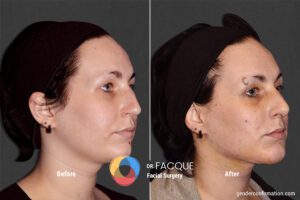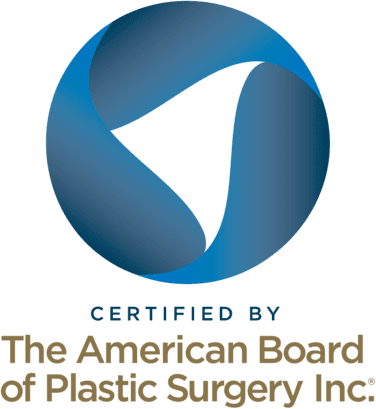Medically reviewed by Jennifer Richman on May 15th, 2025.
What is Rhinoplasty for Gender Affirmation
Gender-affirming rhinoplasty or transgender rhinoplasty is a specialized procedure designed to help transgender and non-binary individuals align their facial features with their gender identity. The goal of this procedure is to affirm an individual’s gender by reversing or inducing the effects that testosterone has on the development of the nose contour. Surgeons make precise adjustments, such as reshaping nasal bones and cartilage along the bridge and tip of the nose, to achieve the desired appearance.
Unlike cosmetic rhinoplasty, which is typically considered an elective procedure and isn’t covered by insurance, gender-affirming rhinoplasty may be covered when certain criteria are met, one of the most important being a diagnosis of gender dysphoria. Since policies vary, contact your insurance company and healthcare team to understand the approval process and coverage details.
Beyond helping to reduce gender dysphoria, rhinoplasty can also address functional concerns like breathing difficulties. Surgeons can alter both form and function, using advanced techniques to reshape the nose while ensuring the nasal passages remain structurally sound. Of course, like any surgery, there are potential risks, including nasal obstruction, swelling, and the possibility of needing revisions. That’s why it’s so important for patients to gain realistic expectations from a free rhinoplasty consultation with a board-certified surgeon.
Feminization Rhinoplasty for Facial Feminization Surgery (FFS)
Feminization rhinoplasty is often a key part of facial feminization surgery (FFS), aimed at reshaping the nose in a way that better reflects a patient’s feminine gender identity. Because testosterone influences facial features during puberty, it can create nasal characteristics that may feel more masculine.
During feminization rhinoplasty, the procedure often involves narrowing the nasal bridge. On patient request, any dorsal bumps along the bridge can be flattened, and the width of the bridge itself can be reduced. By altering the nasal bridge, the nasofrontal angle (the angle between the nose bridge and the eyebrow ridge) is increased. This tends to be larger in someone who went through a first, estrogen-dominant puberty. Please note that not all patients want bumps in their nasal bridge to be smoothed out as part of their procedure.
Additionally, the tip of the nose can be rotated to achieve a slight upward tilt, while its overall projection is reduced.
At the Gender Confirmation Center (GCC), we take a personalized approach to feminization rhinoplasty, recognizing that each patient’s goals are unique. We collaborate closely with our patients to ensure that the results feel authentic and align with their personal preferences.
Masculinization Rhinoplasty for Facial Masculinization Surgery (FMS)
Facial masculinization rhinoplasty, as a part of facial masculinization surgery (FMS), aims to reshape the nose to resemble the changes testosterone brings to cartilage growth, resulting in an overall larger size, a wider nose bridge, and more pronounced projection. To imitate these effects surgically, your surgeon can widen the nasal bridge, straighten any dorsal humps and adjust the tip of the nose to achieve a slight downward tilt while increasing its overall projection.
These enhancements can be achieved using cartilage grafts from the patient, often sourced from the rib. Additionally, implants can be constructed from materials such as silicone or ePTFE to reinforce the structure and refine the nasal framework.
Instead of focusing solely on changing the shape, masculinization rhinoplasty aims to enhance structural harmony, ensuring that the nose complements the overall balance of the face. There is no standardized approach. At the GCC, the process is highly personalized, with adjustments made to ensure that the outcome aligns with the vision of our patients.
Non-Binary Rhinoplasty
There is no one-size fits-all approach to a gender-affirming rhinoplasty for a non-binary patient seeking facial surgery. Patients can choose any combination of what some call “feminizing” techniques that smooth out and reduce the dimensions of the nose or “masculinizing” techniques that seek to augment the dimensions of the nose, making them more prominent and angular. Instead of thinking about a rhinoplasty in terms of feminizing vs. masculinizing techniques, it can be helpful for patients to think about which parts of their nose they would like reduced or augmented.
The GCC is at the forefront of developing techniques tailored to non-binary patients, bringing both innovation and expertise to gender-affirming surgery. If you are considering non-binary rhinoplasty, a free virtual or in-person consultation with one of our expert surgeons allows you to create a personalized plan tailored to your needs, goals, and anatomy.
Frequently Asked Questions about Transgender Rhinoplasty
Who is a good candidate for transgender rhinoplasty?
Transgender rhinoplasty is a specialized procedure available to adults who can provide informed consent, ensuring they understand the process and outcomes before moving forward. Ideal candidates for this surgery are those in optimal health and those who have realistic expectations about the outcomes, which are discussed during a free consultation.
Factors such as skin elasticity and thickness can affect how much the nose’s prominence can be adjusted. At the GCC, hormone replacement therapy (HRT) is not a requirement to undergo transgender rhinoplasty. For patients on HRT, we recommend that you undergo treatment for at least 12 months before considering gender-affirming facial surgery. Waiting 1-1.5 years on full-dose HRT allows facial changes to fat redistribution and changes in soft tissue to stabilize. This guideline is less critical for rhinoplasty, as hormones do not affect nasal cartilage or bone in adults.
How can I get a rhinoplasty for gender affirmation?
The first step to get a rhinoplasty is to request a consultation with a board-certified surgeon specializing in gender-affirming procedures. If your consultation is virtual, you will be asked to submit photos of your nose for evaluation so your surgeon can assess your facial structure and tailor recommendations to your goals. For more info, click here.
Does a rhinoplasty or nose job leave scars?
Whether rhinoplasty leaves scars depends on the procedure. A closed rhinoplasty, with incisions inside the nostrils, leaves no visible scarring. An open rhinoplasty, which is the most common technique, requires an incision between the underside of the nostrils, but it usually heals well without noticeable scarring. If combined with a lip lift, an incision at the base of the nose can leave a visible scar, though scar care treatments can help reduce its appearance over time.
Is a rhinoplasty painful?
Rhinoplasty isn’t typically considered a painful procedure, especially in comparison to other facial surgeries. Most patients describe the recovery process as more uncomfortable than painful, mainly due to swelling, congestion, and the temporary difficulty breathing through the nose.
How much does a rhinoplasty cost?
The cost of rhinoplasty in the U.S. may vary, with some providers charging as much as $18,000 for patients paying without insurance coverage. When obtaining a quote, be sure to ask whether the price includes only the surgeon’s fee or if it also covers additional costs such as facility and anesthesia fees, as these can significantly increase the total expense.
Will insurance cover a rhinoplasty?
Some insurance providers cover gender-affirming rhinoplasty if specific requirements are met. These criteria typically include obtaining a support letter from a licensed mental health professional who confirms a diagnosis of gender dysphoria. Additionally, patients generally need to have been on continuous hormone replacement therapy (HRT) for at least 12 months, unless a medical condition prevents them from doing so.
Recovery from Transgender Rhinoplasty
Recovering from a feminizing rhinoplasty and a masculinizing rhinoplasty is a gradual process, with initial swelling, congestion, and mild discomfort in the first few days. Here’s what to expect after surgery:
- You’ll most likely leave with a cast on top of the nasal bridge and may have internal splints resting along the internal septum of the nose. You will have a gauze dressing located between the nose and upper lip to catch blood and secretions, typically needing to be changed a few times a day. This gauze can usually be removed within 24-48 hours, depending on your surgeon’s instructions.
- Inflammation and discomfort typically peak within the first 72 hours, gradually easing. As inflammation subsides, the nose may appear asymmetric, which should resolve over time.
- Bruising, commonly in the under-eye region, lasts about 2-3 weeks.
- Avoid blowing your nose for two weeks and placing any pressure on the bridge (like glasses) for three months.
- Using saline spray for four weeks helps maintain moisture, prevent infection and crusting, and support healing.
- Full results may take up to 12 months as swelling continues to decrease.
Click Here to Request the Next Steps to Schedule a Consult!
We offer complimentary virtual and in-person consultations with our board-certified surgeons. Click here to complete our consultation request form to learn more about the next steps in your patient journey.
BOOK CONSULTATION




